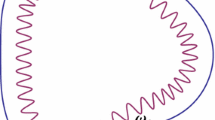Abstract
In this paper, we study global attractors for implicit discretizations of a semilinear parabolic system on the line. It is shown that under usual dissipativity conditions there exists a global (Z u ,Z ρ )-attractor \(A\) in the sense of Babin-Vishik and Mielke-Schneider. Here Z ρ is a weighted Sobolev space of infinite sequences with a weight that decays at infinity, while the space Z u carries a locally uniform norm obtained by taking the supremum over all Z ρ norms of translates. We show that the absorbing set containing \(A\) can be taken uniformly bounded (in the norm of Z u ) for small time and space steps of the discretization. We establish the following upper semicontinuity property of the attractor \(A\) for a scalar equation: if \(A\) N is the global attractor for a discretization of the same parabolic equation on the finite segment [−N,N] with Dirichlet boundary conditions, then the attractors \(A\) N (properly embedded into the space Z u ) tend to \(A\) as N→∞ with respect to the Hausdorff semidistance generated by the norm in Z ρ . We describe a possibility of “embedding” certain invariant sets of some planar dynamical systems into the global attractor \(A\). Finally, we give an example in which the global attractor \(A\) is infinite-dimensional.
Similar content being viewed by others
References
Afraimovich, V., and Pesin, Ya. (1993). Travelling waves in lattice models of multi-dimensional and multi-component media: I. General hyperbolic properties. Nonlinearity 6, 429–455.
Babin, A. V., and Vishik, M. I. (1990). Attractors of partial differential evolution equations in an unbounded domain. Proc. Roy. Soc. Edinburgh Sect. A 116, 221–243.
Babin, A. V., and Vishik, M. I. (1992). Attractors of Evolutionary Equations, North-Holland.
Bates, P. W., Lu, K., and Wang, B. (2001). Attractors for lattice dynamical systems. Internat. J. Bifur. Chaos 11, 143–153.
Collet, P. (1994). Thermodynamic limit of the Ginzburg-Landau equations. Nonlinearity 7, 1175–1190.
Eirola, T., and Pilyugin, S. Yu. (1996). Pseudotrajectories generated by a discretization of a parabolic equation. J. Dynam. Differential Equations. 8, 281–297.
Feireisl, E., et al. (1994). Compact attractors for reaction-diffusion equations in ℝn. C. R. Acad. Sci. Paris Sér. I 319, 147–151.
Hale, J. K. (1988). Asymptotic behavior of dissipative systems. Math. Surv. Monogr. 25, Am. Math. Soc.
Hale, J. K., Lin, X. B., and Raugel, G. (1988). Upper semicontinuity of attractors for approximations of semigroups and partial differential equations. Math. of Comp. 50, 89–123.
Hale, J. K., and Raugel, G. (1989). Lower semicontinuity of attractors of gradient systems and applications, Ann. Mat. Pura Appl. CLIV, 281–326.
Hale, J. K. (1994). Numerical dynamics. In Kloeden, P., and Palmer, K. (Eds.), Chaotic Numerics, Amer. Math. Soc., pp. 1–30.
Ladyzhenskaya, O. A. (1991). Attractors for Semi-Groups and Evolution Equations, Cambridge University Press.
Ladyzhenskaya, O. A. (1991). Globally Stable Difference Schemes and Their Attractors, Preprint POMI P-5-91, St. Petersburg.
Mielke, A., and Schneider, G. (1995). Attractors for modulation equations on unbounded domains—existence and comparison. Nonlinearity 8, 743–768.
Mielke, A. (1997). The complex Ginzburg-Landau equation on large and unbounded domains: sharper bounds and attractors. Nonlinearity 10, 199–222.
Mielke, A. (1999). The Ginzburg-Landau equation in its role as a modulation equation. Preprint 20/99, DFG-SPP Ergodentheorie, Analysis und effiziente Simulation Dynamischer Systeme. To appear in Fiedler, B., (Ed.)Handbook of Dynamical Systems II.
Oliva, W. M., Kuhl, N. M., and Magalhães, L. T. (1993). Diffeomorhisms of ℝn with oscillatory Jacobians. Publ. Mat. 37, 255–269.
Riesz, R., and Sz.-Nagy, B. (1972). Leçons d'Analyse Fonctionelle, Budapest.
Sell, G. R., and You, Y. (2002). Dynamics of Evolutionary Systems, Appl. Math. Sci., Vol. 143, Springer.
Stuart, A. M., and Humphries, A. R. (1996). Dynamical Systems and Numerical Analysis, Cambridge University Press.
Temam, R. (1988). Infinite Dimensional Systems in Mechanics and Physics, Springer.
Zhou, S. (2002). Attractors for second order lattice dynamical systems. J. Differential Equations, 179, 605–624.
Author information
Authors and Affiliations
Rights and permissions
About this article
Cite this article
Beyn, WJ., Pilyugin, S.Y. Attractors of Reaction Diffusion Systems on Infinite Lattices. Journal of Dynamics and Differential Equations 15, 485–515 (2003). https://doi.org/10.1023/B:JODY.0000009745.41889.30
Issue Date:
DOI: https://doi.org/10.1023/B:JODY.0000009745.41889.30



